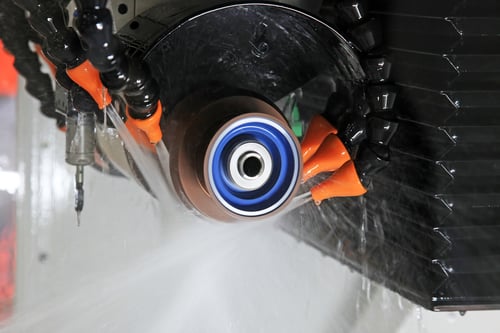Is Your Grinding Wheel the Issue or Your Machine?
Precision grinding is an intricate process where even the slightest misalignment or malfunction can lead to significant issues. Often, when problems arise, the immediate suspicion falls on the grinding wheel. However, the grinding machine itself can often be the root cause of these issues. This detailed troubleshooting guide focuses on distinguishing between grinding wheel issues and grinder-related problems.
Evaluating the Source of Grinding Issues
Identifying Machine-Related Concerns
Consistency Across Various Wheel Brands
- Ongoing Issues Despite Brand Changes: If switching between different abrasive wheel brands doesn't resolve the grinding issues, it strongly points towards a machine-related problem.
- Brand Performance Analysis: Documenting performance metrics across different wheel brands can provide valuable insights into whether the issue is consistent, indicating machine faults.
Abrupt Changes in Wheel Performance
- Sudden Performance Deterioration: A wheel that suddenly starts performing poorly on the same machine tool, especially if it was functioning effectively before, can indicate machine problems.
- Performance Trend Analysis: Monitoring and comparing current wheel performance against historical data helps in identifying if the machine has developed new issues.
Rapid Wheel Deterioration
- Rapid or Uneven Wheel Wear: A grinding wheel in good condition that begins to wear out faster than usual on the same workpiece or shows uneven wear patterns can be responding to underlying machine issues.
- Wear Pattern Documentation: Keeping a log of wheel wear patterns over time can aid in diagnosing whether the machine is the cause of these issues.
In-Depth Machine Analysis
The Spindle Bearings
The Pivotal Component
- Critical Role in Grinding: Spindle bearings are integral to the machine's precision and smooth operation. Their failure or malfunction can lead to significant grinding problems, often mistaken for wheel issues.
- Indicators of Bearing Problems: Unusual noises, vibrations, and a noticeable decrease in surface finish quality are common symptoms of bearing failure.
Maintenance and Inspection Protocols
- Scheduled Inspections: Establishing a routine for checking bearing conditions, including listening for noises and checking for play or movement, is crucial.
- Preventative Maintenance: Proactive maintenance, including timely replacement of bearings showing signs of wear, can prevent many machine-related grinding problems.
Coolant System Importance
Vital for Effective Grinding
- Coolant's Role: Proper oil coolant usage is essential for effective grinding. Inadequate or improper coolant use can lead to issues typically attributed to wheel problems, such as overheating and inefficient grinding.
- Typical Coolant Issues: Dirty coolant can lead to a buildup clogging the wheel and inefficient cooling, while misaligned coolant nozzles can result in inadequate wheel lubrication and cooling.
Coolant System Management
- Routine Coolant Maintenance: Regularly cleaning the coolant system and replacing the coolant prevents contamination, which can affect grinding quality.
- Coolant Nozzle Optimization: Adjusting and maintaining the proper alignment of coolant nozzles is crucial for effective wheel cooling and swarf removal.
Clamping and Fixturing
Effect on Grinding Stability
- Influence on Grinding Outcomes: Inadequate clamping can cause vibrations and instability during grinding, leading to wheel deformation and rapid wheel wear.
- Optimal Clamping Configuration: Regular inspection and adjustment of clamping mechanisms ensure the stability and accuracy of the grinding process.
Clamping System Care
- Routine Clamping Checks: Inspect clamps for signs of wear and ensure they are correctly positioned and tightened for each grinding operation.
- Component Replacement: Worn clamping components should be replaced promptly to maintain optimal grinding conditions.
Belt Drive System Analysis
Key to Machine Operation
- Transmission of Power: The condition of the drive belts directly affects the grinding machine's performance. Poorly maintained belts can lead to inconsistent wheel speeds and uneven grinding.
- Signs of Belt Issues: Fluctuating machine RPMs, inconsistent grinding results, and rapid wheel degradation can indicate belt problems.
Belt Maintenance Strategies
- Regular Belt Inspections: Inspect the drive belts for signs of wear and proper tension.
- Proactive Belt Replacement: Replace belts showing signs of wear or insufficient tension to maintain consistent machine performance and prevent grinding inconsistencies.
Advanced Machine Diagnostic Techniques
CNC Machine Calibration and Alignment
- Precision Maintenance: Regularly calibrate and align all machine components to ensure precision grinding. Misalignment can cause uneven wheel wear and a poor grind on the cutting tool, often mistaken for wheel issues.
- Alignment Verification: Regular checks of component alignment are essential. Misalignments can lead to a range of grinding problems that mimic wheel deficiencies.
Lubrication System Efficacy
- Reducing Friction and Wear: Adequate lubrication of machine components is critical for reducing wear and maintaining grinding precision.
- Lubrication System Checks: Regularly inspect and maintain the lubrication system to ensure it functions optimally, as insufficient lubrication can cause overheating, wear, and affect grinding quality.
Environmental Stability
- Work Environment Impact: Changes in temperature and humidity can affect the precision and stability of grinding machines.
- Environmental Control: Maintain a controlled and stable workshop environment to ensure consistent machine performance and prevent grinding issues caused by environmental factors.
Identifying Wear and Tear
- Long-Term Machine Usage Effects: Over time, machines can develop wear and tear, affecting their grinding capabilities.
- Proactive Wear Inspection: Conduct regular checks for signs of damage, such as loose components or decreased accuracy, and address them to prevent grinding issues. While daily maintenance isn’t required, regular maintenance is crucial to catch issues before they evolve.
![]()
Determining whether grinding issues stem from the wheel or the machine requires a thorough understanding of both components. By focusing on detailed machine maintenance, including spindle bearings, coolant systems, clamping, belts, and incorporating advanced diagnostics, you can effectively diagnose and resolve grinding challenges, ensuring optimal performance and longevity of both the wheel and the machine.
Recent Posts
Subscribe to email updates
Subscribe to our blog to get the latest updates from the experts on Grinding Wheels! You can easily unsubscribe at any time




